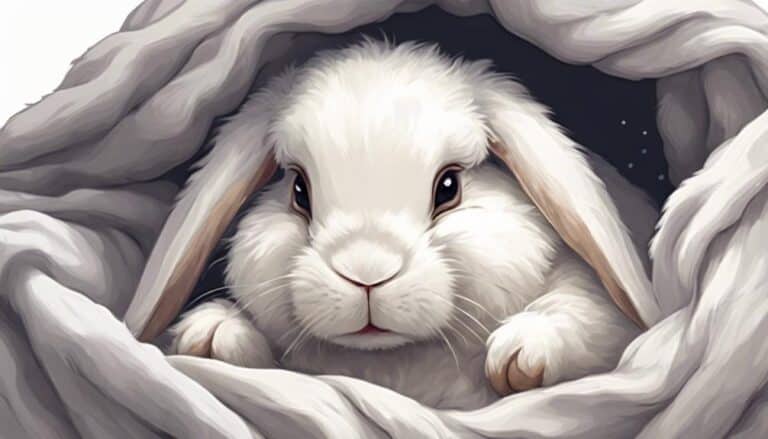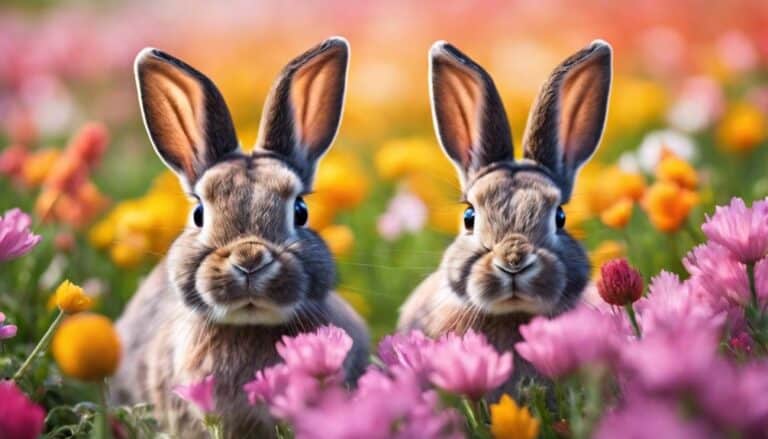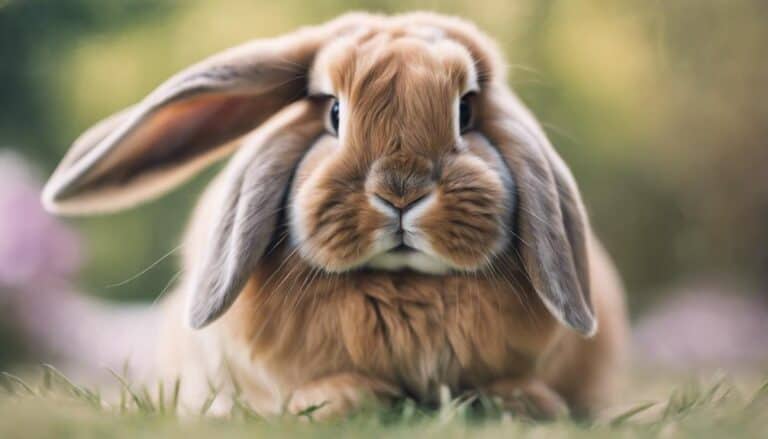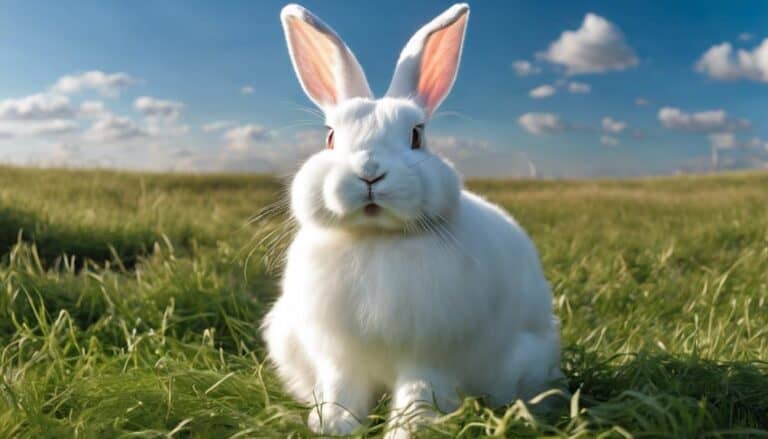Bunnies survive winter by growing a thick fur coat to trap heat and keep warm in temperatures as low as 32°F. They make cozy underground burrows with straw and snuggle up together to stay toasty. They also adjust their diet to include twigs and roots to stay healthy, and yes, they even eat their poop to get essential nutrients. It may sound strange, but it helps them survive!
Unlike some animals that hibernate, rabbits don't take long winter naps. Instead, they conserve energy by sleeping more and using their ears and fur to regulate their body temperature. Having multiple shelters within a 5-mile radius is super important for their protection. It gives them places to hide and stay safe from harsh weather and predators.
If humans lend a helping hand by providing food and shelter, it can make a big difference for bunnies trying to survive the cold winter months. Their ability to adapt and bounce back is truly amazing. Winter survival for bunnies is a cool story of how they tough it out and keep going strong.
Contents
- 1 Key Takeaways
- 2 Winter Fur Adaptations
- 3 Underground Shelter Strategies
- 4 Winter Diet Adjustments
- 5 Coprophagy for Nutrient Intake
- 6 No Hibernation, Increased Sleep
- 7 Nest Building Techniques
- 8 Temperature Regulation Mechanisms
- 9 Importance of Multiple Shelters
- 10 Human Assistance in Winter Survival
- 11 Monitoring Bunnies' Winter Health
- 12 Frequently Asked Questions
- 13 Conclusion
Key Takeaways
Thick fur helps these animals stay warm by trapping heat. It's like wearing a cozy sweater all the time! Underground burrows are like their own little homes, with insulation to keep the cold out and the warmth in.
When it comes to food, these animals have adjusted their diets to include rougher foods that give them the energy they need to stay active. It's like they're eating their version of a power bar!
One interesting thing they do is called coprophagy, which is just a fancy word for eating their own poop. Gross, right? But it actually helps them recycle nutrients and stay healthy. It's like a natural way for them to get extra vitamins and minerals.
Instead of hibernating, these animals have found another way to conserve energy – by sleeping more. So, they might not be up and about all the time, but they're still getting the rest they need to stay strong and healthy. It's like hitting the snooze button on life!
Winter Fur Adaptations
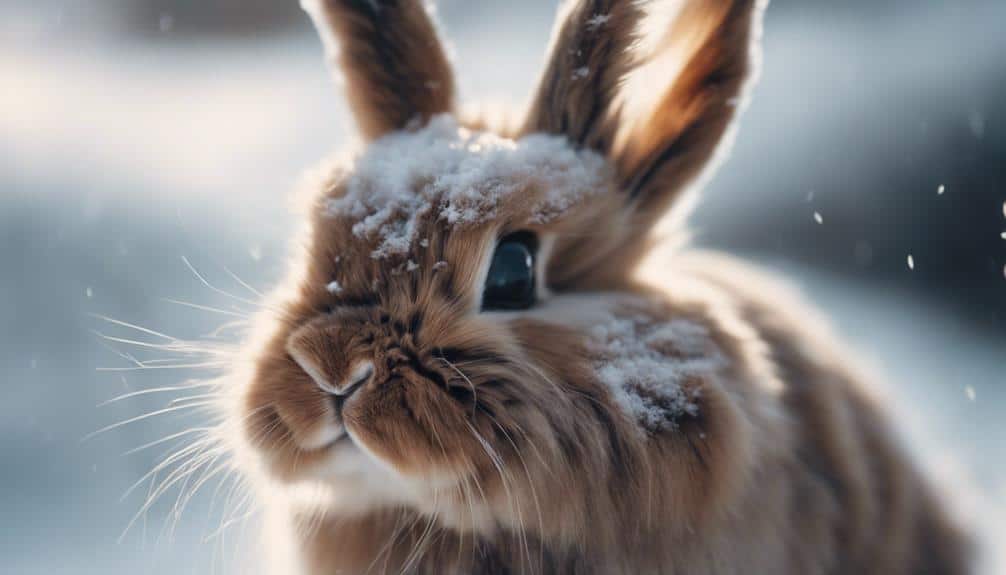
During winter, bunnies grow a thick fur coat to help them survive the cold season. This winter fur isn't just for looks; it's a key adaptation that helps rabbits deal with the chilly temperatures. The thick fur acts like a warm blanket, trapping heat close to the bunny's body and stopping it from escaping into the cold air. This is super important because bunnies need to keep their body temperature between 101-103 degrees Fahrenheit to stay healthy.
When it gets cold, bunnies rely on their winter fur to protect them from the harsh weather. This furry coat helps them feel cozy even when it's as chilly as 32 degrees Fahrenheit. The thick fur also helps them keep their body heat, which lets them save energy and survive the winter better. So, next time you spot a bunny hopping around in the snow, remember that their fluffy winter fur isn't just for show; it's a crucial survival tool in the cold season.
Underground Shelter Strategies
Rabbits make cozy homes underground using straw, grass, and twigs to stay warm in the cold. These burrows are like a fortress against the winter chill, keeping them toasty by snuggling up together.
Burrowing for Warmth
When winter rolls around, bunnies do something pretty amazing. They dig underground to make cozy shelters filled with straw, grass, and twigs to stay warm. This helps them regulate their body temperature and save energy when it's cold outside. It's like their own little winter hideout!
Bunnies are smart about where they set up these shelters. They make sure to have a few different ones within a 5-mile area. This way, they can always find a safe and warm spot, even when it's freezing cold.
These underground burrows are like a bunny's version of a snug winter home. They keep them protected from the harsh weather and any pesky predators looking for a meal during the winter months. It's their secret spot where they can relax, stay toasty, and make it through the winter season like pros.
Huddling for Insulation
When it gets really cold outside, bunnies huddle up together underground to stay warm. They use their body heat to keep each other cozy and protected from the harsh winter weather. Their underground shelters are filled with straw, grass, and twigs, creating a snug place to ride out the cold. By sticking close together, the bunnies can handle even the toughest winter months.
To make sure they’ve enough safe spots, bunnies create several shelters within a 5-mile range. This way, they can stay safe and find food without venturing too far. By using these underground dens, bunnies show how they can adapt and survive in the face of winter challenges. Their strategy of huddling together for warmth is a smart move that helps them thrive in the coldest climates. Additionally, these shelters not only provide warmth but also serve as a refuge from predators, keeping bunnies safe from cats and other threats. The clever use of underground burrows allows them to quickly escape if danger approaches. Through these adaptations, bunnies exemplify resilience, ensuring their survival even in harsh environments.
Winter Diet Adjustments
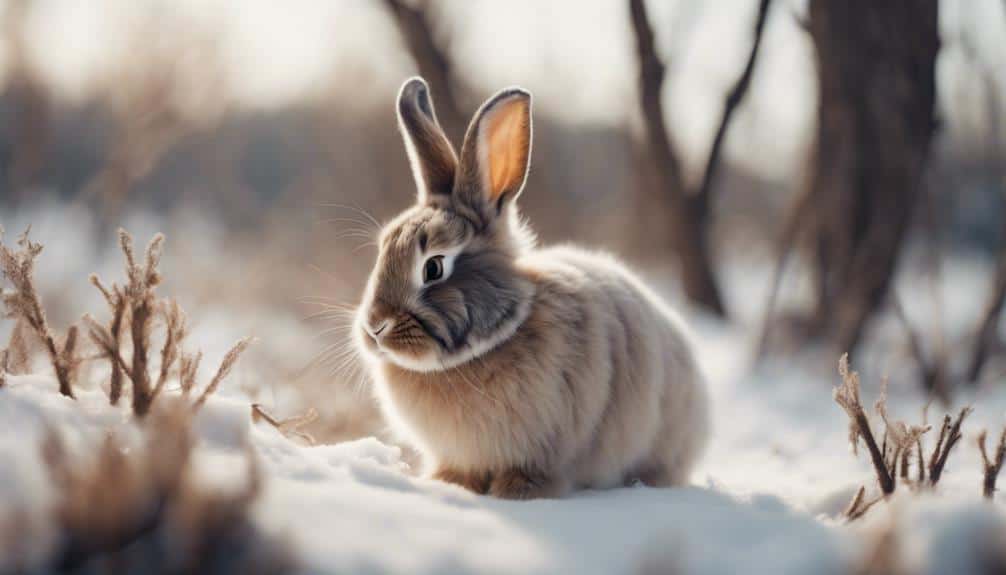
During winter, wild rabbits change up their diet to make sure they get all the nutrients they need when their usual food is hard to find. The cold weather and lack of their favorite foods push these fluffy guys to eat different things.
So, when leafy plants are scarce, wild rabbits chomp on twigs, bark, and pine cones to keep their bellies happy. They also dig into roots, evergreen needles, and any kind of foliage they can find to stay healthy during the winter. Their go-to foods may not be around as much, so they switch it up by munching on rougher stuff.
Coprophagy for Nutrient Intake
Rabbits eat their own poop to get extra nutrients from their food. It might sound gross, but it's actually a smart survival strategy, especially during winter.
When rabbits eat their soft, partially digested poop pellets, they can absorb more nutrients from their food. This helps them get important vitamins, amino acids, and proteins that they might miss out on otherwise.
Nutrient-Rich Bunny Poop
Rabbits have a cool trick up their sleeves when it comes to surviving – they eat their own poop! Yep, you heard that right. This fancy term for it's coprophagy, and it's actually super important for them. By munching on their soft fecal pellets, rabbits can get extra nutrients like vitamins B and K. This comes in handy, especially during the winter when food might be hard to find.
When rabbits chow down on their poop, they're not just being gross – they're being smart. Those little pellets are full of good stuff thanks to all the helpful microbes hanging out in there. By giving their poop a second go-round in their digestive system, rabbits can squeeze out even more proteins and vitamins that are essential for keeping them healthy and happy.
Digestive System Efficiency
Rabbits have a unique way of making sure they get all the nutrients they need to stay healthy. They've a habit called coprophagy, which means they eat certain droppings to re-digest important stuff like fiber, proteins, and vitamins. This helps them get the most out of their food and keep their bodies running smoothly.
When rabbits eat these special soft droppings, it helps their digestive system work better. This way, they can make sure they're getting all the essential nutrients their bodies need to stay strong and healthy. It's like a little recycling system that helps them save energy and get the most out of their food, especially when it's cold outside and food mightn't have everything they need.
Coprophagy is like a superpower for rabbits, especially in the winter when it's harder to find good food. By re-digesting their droppings, they can stay warm and healthy even when resources are limited. This clever way of digesting food helps rabbits survive tough winter conditions and keep thriving no matter what.
Essential Dietary Recycling
Rabbits have a unique way of getting extra nutrients from their food. They actually eat their own poop! This might sound gross, but it's a natural process called coprophagy. By doing this, rabbits can make sure they get all the vitamins and fiber they need to stay healthy.
When rabbits eat their poop, they're able to get more nourishment from their food. This is because the poop contains partially digested food pellets that still have nutrients in them. So, by eating their poop, rabbits can extract even more goodness from what they eat.
This behavior is super important for wild rabbits, especially in the winter when food is harder to find. By eating their poop, rabbits can stay warm and well-fed, which helps them keep their energy levels up. So, even though it might seem weird, coprophagy is actually a clever way for rabbits to make sure they stay healthy all year round.
No Hibernation, Increased Sleep
During winter, bunnies don't hibernate like some animals do. Instead, they just sleep more to save energy. If you see rabbits in your yard in the winter in the United States, you might notice they take short naps that last 25 to 30 minutes. This helps them conserve energy and stay warm when it's cold outside. By sleeping more, rabbits don't move around as much, which means they use less energy. They also have brown fat that burns to keep them warm in chilly weather, acting like a natural heater to maintain their body temperature.
Rabbits have a cool trick to regulate their body temperature. Their ears have lots of blood vessels that help them release heat, and they use their fat stores to stay insulated and cozy. So, even though they're active during the winter, they've got some savvy survival tactics to stay toasty and comfy.
Nest Building Techniques
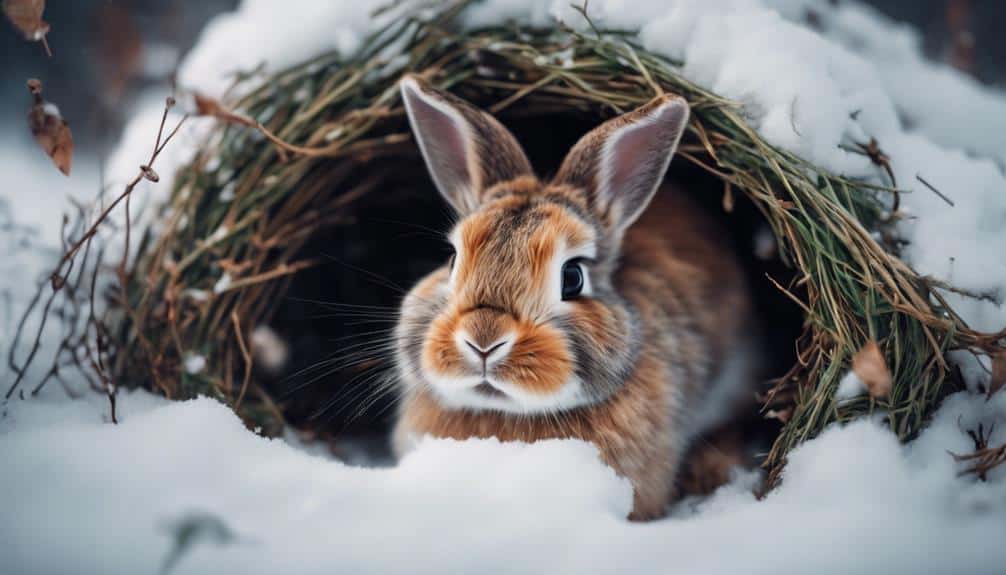
Bunnies are pretty smart when it comes to making their cozy nests. They gather up grass, straw, and twigs to build a warm and comfy home for themselves during the winter. These nests are like their own little shelters that keep them safe from the bad weather.
You know what's really cool? Bunnies use fur from their own bodies to line their nests. It's like wearing a fur coat inside their home! This extra layer helps keep them warm when it gets really cold outside.
And get this, bunnies are strategic about where they build their nests. They look for hidden spots under bushes or in thick bushes to stay safe from predators and strong winds. It's like they've their own secret hideouts!
Sometimes, bunnies even use nearby brush piles to make their nests even better. It's like adding an extra layer of protection from the cold and any predators that might come snooping around. Smart, right?
Temperature Regulation Mechanisms
Rabbits are pretty smart when it comes to keeping their bodies at the right temperature. They usually run at about 101-103°F, but when it gets super cold, they've got some tricks up their sleeves. Their ears are key players in this temperature game because they're loaded with blood vessels that help them release extra heat. When it's chilly, rabbits can cut back on blood flow to their arms and legs to hold onto that warmth.
Oh, and let's not forget about their fur – it's like their built-in cozy jacket! By trapping air close to their bodies, their fur acts as insulation, giving them extra protection from the cold. In the winter, rabbits can rev up their metabolism to create more body heat, which helps them stay toasty. And when it gets really cold, they might snuggle up with their buddies in burrows or shelters to share that warmth.
Those evergreen trees? They're like nature's winter coats for rabbits. By hanging out near them, rabbits can get extra shelter from harsh weather, making it easier for them to survive the winter months.
Importance of Multiple Shelters
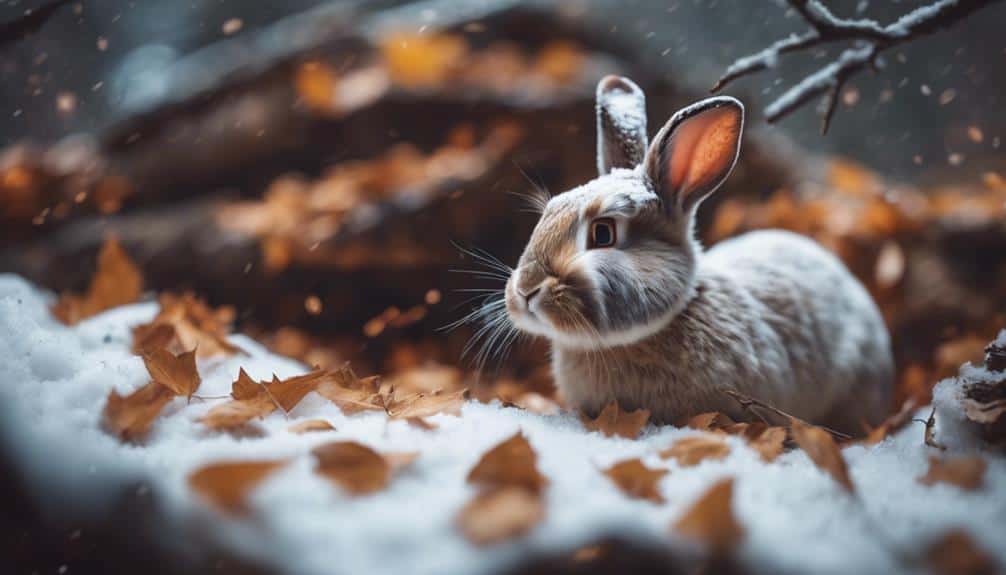
Having multiple shelters is super important for helping rabbits survive the harsh winter months. Imagine being a rabbit trying to stay warm and safe during the cold season – having access to different shelters within a 5-mile radius is like having your own cozy hideouts!
Rabbits need these shelters to feel safe and insulated from the freezing weather. By having multiple shelters to hop between, they can find protection from the cold and predators. It's like having a bunch of safe havens to escape to if danger lurks nearby.
And let's not forget about comfort and warmth! These shelters should be filled with materials like straw, grass, and twigs to give the rabbits a soft and cozy place to snuggle up in. It's like having a warm blanket on a chilly night – total bunny bliss!
Human Assistance in Winter Survival
So, when it gets super cold in winter, wild rabbits could really use a helping hand from us humans. To help them out, we can give them some extra food like hay, leafy greens, and veggies. This will keep their energy up and help them stay healthy when their usual food is hard to find.
It's also a good idea to set up cozy shelters for them, like brush piles, wooden boxes, or dense shrubs. These shelters will keep them safe from the cold and rough weather. And don't forget to make sure they've access to fresh water, like putting out shallow dishes with unfrozen water. Rabbits need to stay hydrated, especially in winter when it's easy for them to get dehydrated.
To keep them safe from predators looking for a meal during winter, you can set up things like motion-activated lights or fences. These will help protect the rabbits and keep them out of harm's way. By giving them these little boosts, we can really make a big difference in helping wild rabbits survive and thrive during the cold months.
Monitoring Bunnies' Winter Health
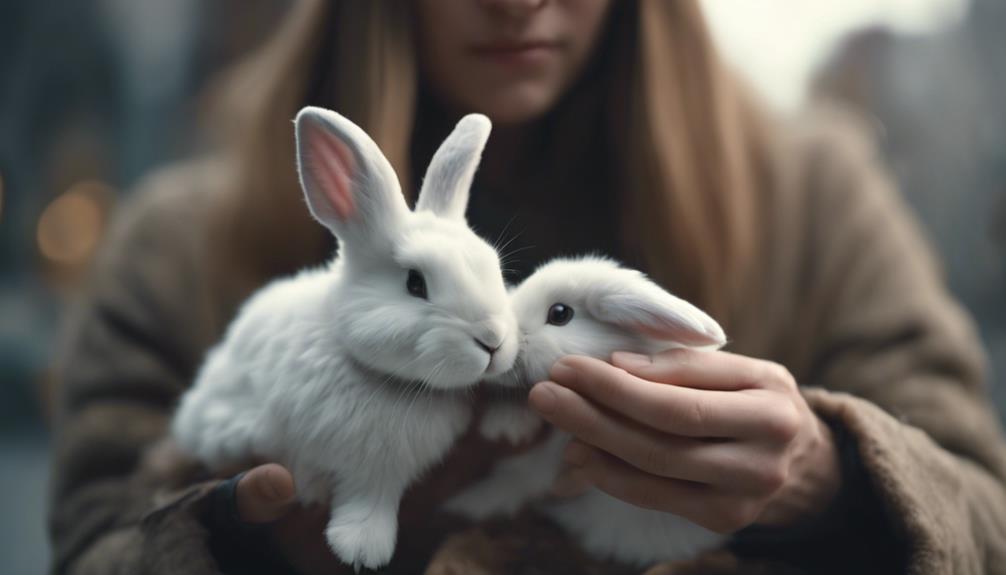
When you're checking on your bunnies in winter, it's important to keep an eye out for signs of hypothermia like cold ears and pale feet. Bunnies can struggle during the winter when there's less food around, so it's crucial to make sure they're doing well. Here are a few things to remember:
- Survival Rate: Keeping an eye on your bunnies' health can really help them make it through the tough winter months.
- Stay Warm: Adding extra insulation and cozy bedding to their shelter can help your bunnies stay warm and snug.
- Spend More Time: Your bunnies might need to hang out in their shelter more during winter to avoid getting too cold.
Frequently Asked Questions
How Cold Is Too Cold for Bunnies?
If you're wondering how cold is too cold for bunnies, just think about their cozy winter shelters, ways to keep them warm, and how they regulate their body temperature. It's important to keep an eye on their well-being during chilly weather. Make sure they have plenty of bedding for warmth and shelter from the wind.
How Do Rabbits Not Freeze in Winter?
Your fluffy fur keeps you warm by trapping heat. During winter, find cozy underground burrows or huddle with friends for extra warmth. Remember to conserve energy by being less active. These simple strategies will help you survive the cold without freezing.
How Do Rabbits Survive Winter With Food?
During the winter, you manage to get through by changing up how you search for food. Rabbits, on the other hand, rely on their thick fur, stored hay, and ability to hibernate to make it through the cold season. They get pretty creative when it comes to finding food to keep them going.
Can Rabbits Stay Outside in Winter?
Rabbits can handle winter outside if they have cozy burrows to keep them warm. They stay toasty by snuggling close together, their fluffy fur acting like a natural blanket. Plus, they can use underground tunnels to stay out of the chilly wind.
Just remember to provide them with food, water, and some shelter to keep them safe and comfortable. With these basics covered, your outdoor rabbits should be just fine during the winter months.
Conclusion
You know how bunnies manage to make it through the winter? They don't actually hibernate like some people think. Instead, they sleep more to save up energy. Their fur coats keep them warm, and they dig underground shelters to stay cozy. Plus, they're pros at finding different hiding spots to escape the cold.
Humans can help out by keeping an eye on the bunnies and making sure they're healthy. With a little care and attention, these fluffy creatures can thrive even when it's freezing outside.

